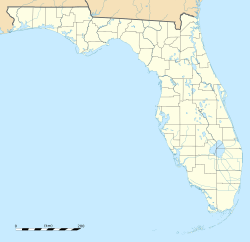Big Mound Key-Boggess Ridge Archeological District facts for kids
Quick facts for kids |
|
|
Big Mound Key-Boggess Ridge Archeological District
|
|
| Location | Charlotte County, Florida |
|---|---|
| Nearest city | Placida, Florida |
| Area | 3,910 acres (15.8 km2) |
| NRHP reference No. | 90001764 |
| Added to NRHP | December 3, 1990 |
The Big Mound Key-Boggess Ridge Archeological District is a very old and important place near Placida, Florida. It is a historic site located on Big Mound Key, which is an island just off the coast. On December 3, 1990, this special place was added to the U.S. National Register of Historic Places. This means it is recognized as a significant historical site that needs to be protected.
Contents
Discovering Big Mound Key
Big Mound Key is found near the southern tip of Cape Haze, right at the entrance to Charlotte Harbor. This archaeological site covers about 13.5 acres (5.5 hectares). It has several interesting features built by ancient people.
What Was Found?
At Big Mound Key, archaeologists have found four large mounds. These mounds are about 20 feet (6 meters) tall and are arranged in a rectangle. There are also long, straight ridges and what might have been canals dug by hand. Most of these mounds and ridges are made mainly from conch shells.
Scientists used a method called radiocarbon dating to find out how old parts of the site are. They found that some parts are about 2,000 years old! Many of the dates and pieces of pottery (called ceramics) found here come from the Weeden Island culture period, which was between 400 and 900 AD.
An Ancient Village
Big Mound Key was likely the site of a large village. It might have been the main center of a powerful group of people led by a chiefdom (a leader or chief). This village may have been an important trading spot. It could have connected the Manasota people from the Tampa Bay area with the Calusa people who lived further south. There is also evidence that the chief of this ancient group lived at the very top of one of the mounds.
Studying the Past
Even though Big Mound Key is very important, archaeologists have not yet done a full excavation (careful digging) and published all their findings. The first surveys of the site were done in the early 1950s by John Mann Goggin and his students. More work was done by Bullen & Bullen in 1956. The pottery found at the site was similar to other types found in south Florida from the Glades Period.
Protecting the Site
Archaeologist George Luer started looking into Big Mound Key more closely after some people used a bulldozer to dig into a mound in 1981. They were looking for Spanish gold. The State of Florida had bought the land in 1978, but not much was done to protect the site at first.
From 2008 to 2011, George Luer led a big excavation of the site after getting a grant from the State of Florida. His work helped us learn more about this amazing historical place.
Different Ideas About the Builders
Archaeologists sometimes have different ideas about which ancient culture built a site. George Luer believed that the site belonged to the Weeden Island culture. This was despite the large shell mounds, the sand ridges, the hand-dug canal, and the common Glades pottery.
Another archaeologist, Jeffrey McClain Mitchem, thought in 1989 that it was a Safety Harbor Culture site. However, newer research suggests the site is much older. It also shares similar earthwork shapes with a famous site called Poverty Point in Louisiana. In 2011, a study linked the Calusa people to the Tunica Indians, who built Poverty Point. There are no known mound complexes on Weeden Island or Safety Harbor that look like Big Mound Key. This makes Big Mound Key very unique and important for understanding ancient Florida.


